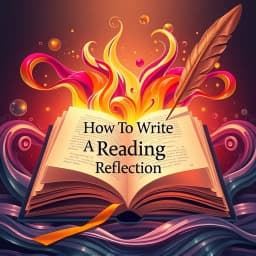
How to Write a Reading Reflection
Find this useful? Bookmark ( CTRL/CMD + D ) for quick access!
Try an example:
Literary Analysis Essay
Personal Reflection Journal
Book Club Discussion Guide
Educational Assignment Template
Critical Thinking Exercise
Thematic Exploration Framework
Explore Similar Tools
Recent Generations
the amount paid directly to you. Yes it is possible in future cases to request direct payment to the provider, Rephrase and give me polished email.
we have processed the claim as per the attachments in the claim submission we have processedthe invoice for Saul Holding. We dont have invoice for the Salofalk.
this additional information is very important. this adiitional information was requested by our clinical team. Without clinical review claim not be paid so please share the below additional information
How To Write A Reading Reflection
How To Write A Reading Reflection is a powerful AI-powered writing assistant that helps users craft insightful and articulate reading reflections. This innovative solution combines advanced natural language processing with user-friendly prompts to deliver well-structured and thoughtful reflections on any text.
Key Capabilities
- Guided Writing Prompts with tailored questions that stimulate critical thinking and help users articulate their thoughts clearly.
- Real-Time Feedback enabling users to refine their writing style and improve clarity, coherence, and engagement.
- Customizable Templates for various types of reading reflections, ensuring that users can adapt their writing to meet specific academic or personal requirements.
- Plagiarism Checker for ensuring originality, giving users confidence that their reflections are unique and authentic.
Who It's For
Designed for students, educators, and avid readers, How To Write A Reading Reflection excels in academic settings and personal development. Whether you're a student preparing for a literature class or a book club member looking to share your insights, this tool streamlines your writing process and enhances your reflective skills.
Why Choose How To Write A Reading Reflection
What sets How To Write A Reading Reflection apart is its intuitive interface and comprehensive support features, making it the ideal solution for anyone looking to deepen their understanding of texts and express their thoughts effectively.
Ready to transform your reading reflections? Start using How To Write A Reading Reflection today and experience the difference in your writing journey!
Enhance Your Work with How to Write a Reading Reflection
Leverage the power of AI to streamline your tasks with our How to Write a Reading Reflection tool.
Guided Reflection Prompts
Receive tailored prompts that guide you through the reflection process, helping you articulate your thoughts and insights effectively.
Smart Editing Suggestions
Utilize AI-driven editing suggestions to enhance clarity, coherence, and engagement in your reading reflections.
Structured Reflection Templates
Access a variety of structured templates designed to organize your reflections, ensuring a comprehensive and cohesive output.
How How to Write a Reading Reflection Works
Discover the simple process of using How to Write a Reading Reflection to improve your workflow:
Select Your Reading Material
Choose the book or article you want to reflect on for your reading reflection.
Input Key Themes
Enter the main themes, ideas, or questions that stood out to you while reading.
Generate Reflection
The AI tool processes your input and generates a structured reading reflection based on your themes.
Review and Edit
Review the generated reflection and make any necessary edits to personalize it further.
Use Cases of
How to Write a Reading Reflection
Explore the various applications of How to Write a Reading Reflection in different scenarios:
Student Reading Reflection
Assist students in crafting thoughtful reflections on their reading assignments, enhancing comprehension and critical thinking skills.
Book Club Discussions
Provide prompts and guidance for book club members to articulate their thoughts and insights, fostering deeper discussions.
Literary Analysis Preparation
Help literature students prepare for essays or exams by generating structured reflections that analyze themes, characters, and plot developments.
Teacher Feedback Tool
Enable educators to create tailored reading reflection assignments that encourage students to engage with texts on a personal level.
Who Benefits from How to Write a Reading Reflection?
AI-Powered Efficiency
From individuals to large organizations, see who can leverage How to Write a Reading Reflection for improved productivity:
Students
Enhance comprehension and critical thinking skills through structured reading reflections.
Educators
Facilitate meaningful discussions and assessments by guiding students in their reflections.
Literature Enthusiasts
Deepen appreciation for texts by articulating thoughts and insights effectively.
Book Clubs
Encourage engaging conversations and diverse perspectives through reflective writing.
Frequently Asked Questions
What is 'How To Write A Reading Reflection' AI tool?
The 'How To Write A Reading Reflection' AI tool is designed to assist users in crafting thoughtful and structured reflections on their reading materials, helping to enhance comprehension and critical thinking.
Is the tool suitable for all types of reading materials?
Yes, the tool can be used for a variety of reading materials, including books, articles, and essays, making it versatile for students, educators, and avid readers alike.
How does the AI generate reading reflections?
The AI analyzes the content provided by the user, identifies key themes and ideas, and generates a structured reflection that includes personal insights, summaries, and critical analysis.
Can I customize the reflection generated by the AI?
Absolutely! Users can edit and customize the generated reflection to better fit their personal voice and specific requirements, ensuring that the final output aligns with their thoughts.
Is there a limit to the length of the reading material I can input?
While there is no strict limit, we recommend keeping the input to a manageable length for optimal processing. For best results, consider summarizing longer texts before inputting them into the tool.
































